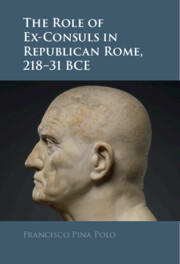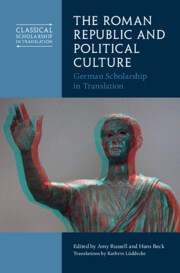Refine search
Actions for selected content:
56 results
Chapter 7 - Cicero, Octavian and the Failure of Republican Leadership
-
-
- Book:
- Leadership in the Ancient World
- Published online:
- 14 September 2025
- Print publication:
- 16 October 2025, pp 153-175
-
- Chapter
- Export citation

The Role of Ex-Consuls in Republican Rome, 218–31 BCE
-
- Published online:
- 01 May 2025
- Print publication:
- 15 May 2025
Chapter 1 - The Scientific Premises for the Imperial artes
- from Part I
-
- Book:
- The <I>artes</I> and the Emergence of a Scientific Culture in the Early Roman Empire
- Published online:
- 22 March 2025
- Print publication:
- 13 February 2025, pp 15-38
-
- Chapter
- Export citation
Chapter 8 - The Message of the Medium
- from Part II - Translations
-
-
- Book:
- The Roman Republic and Political Culture
- Published online:
- 30 January 2025
- Print publication:
- 06 February 2025, pp 225-271
-
- Chapter
- Export citation
Chapter 9 - The memoria of the gentes as the Backbone of Collective Memory in Republican Rome
- from Part II - Translations
-
-
- Book:
- The Roman Republic and Political Culture
- Published online:
- 30 January 2025
- Print publication:
- 06 February 2025, pp 272-293
-
- Chapter
- Export citation
Chapter 3 - Perspectives from Germany
- from Part I - Original Essays
-
-
- Book:
- The Roman Republic and Political Culture
- Published online:
- 30 January 2025
- Print publication:
- 06 February 2025, pp 71-92
-
- Chapter
- Export citation
Chapter 4 - Benevolence and Freedom
- from Part II - Translations
-
-
- Book:
- The Roman Republic and Political Culture
- Published online:
- 30 January 2025
- Print publication:
- 06 February 2025, pp 95-123
-
- Chapter
- Export citation
Chapter 5 - Capitol, Comitium, and Forum
- from Part II - Translations
-
-
- Book:
- The Roman Republic and Political Culture
- Published online:
- 30 January 2025
- Print publication:
- 06 February 2025, pp 124-165
-
- Chapter
- Export citation
Chapter 13 - Publicity or Participation?
- from Part II - Translations
-
-
- Book:
- The Roman Republic and Political Culture
- Published online:
- 30 January 2025
- Print publication:
- 06 February 2025, pp 374-410
-
- Chapter
- Export citation
Chapter 10 - The Ritual Grammar of Institutionalized Politics
- from Part II - Translations
-
-
- Book:
- The Roman Republic and Political Culture
- Published online:
- 30 January 2025
- Print publication:
- 06 February 2025, pp 294-327
-
- Chapter
- Export citation
Chapter 12 - Monuments and Consensus
- from Part II - Translations
-
-
- Book:
- The Roman Republic and Political Culture
- Published online:
- 30 January 2025
- Print publication:
- 06 February 2025, pp 350-373
-
- Chapter
- Export citation
Chapter 11 - Aristocratic Roles and the Crisis of the Roman Republic
- from Part II - Translations
-
-
- Book:
- The Roman Republic and Political Culture
- Published online:
- 30 January 2025
- Print publication:
- 06 February 2025, pp 328-349
-
- Chapter
- Export citation
Chapter 7 - Rituals of Integration in the Roman Republic
- from Part II - Translations
-
-
- Book:
- The Roman Republic and Political Culture
- Published online:
- 30 January 2025
- Print publication:
- 06 February 2025, pp 200-224
-
- Chapter
- Export citation
Chapter 6 - Face to Face with the Ancestors
- from Part II - Translations
-
-
- Book:
- The Roman Republic and Political Culture
- Published online:
- 30 January 2025
- Print publication:
- 06 February 2025, pp 166-199
-
- Chapter
- Export citation
Chapter 2 - Politics and Power in the Roman Republic – Then and Now, in Old Europe and the Brave New Anglophone World
- from Part I - Original Essays
-
-
- Book:
- The Roman Republic and Political Culture
- Published online:
- 30 January 2025
- Print publication:
- 06 February 2025, pp 27-70
-
- Chapter
- Export citation
Chapter 1 - Translating Roman Republican Political Culture
- from Part I - Original Essays
-
-
- Book:
- The Roman Republic and Political Culture
- Published online:
- 30 January 2025
- Print publication:
- 06 February 2025, pp 3-26
-
- Chapter
- Export citation

The Roman Republic and Political Culture
- German Scholarship in Translation
-
- Published online:
- 30 January 2025
- Print publication:
- 06 February 2025
5 - Ancient Rome: Monarchy and Republic (753–27 bc)
-
-
- Book:
- The Cambridge History of Strategy
- Published online:
- 06 January 2025
- Print publication:
- 09 January 2025, pp 98-123
-
- Chapter
- Export citation
Chapter 1 - Romanised Muses: The Birth of Latin Literature
-
- Book:
- A History of Latin Literature From its Beginnings to the Age of Augustus
- Published online:
- 14 November 2024
- Print publication:
- 21 November 2024, pp 6-40
-
- Chapter
- Export citation
Chapter 1 - Fractal
- from Part I - “Civis Romanus Sum”
-
- Book:
- Temporal Forms and the Nineteenth-Century Mediterranean
- Published online:
- 09 November 2024
- Print publication:
- 14 November 2024, pp 33-65
-
- Chapter
- Export citation
